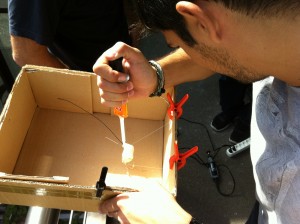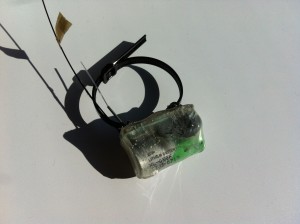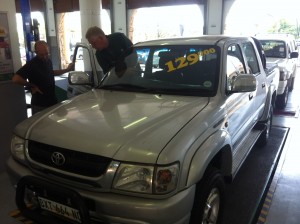Cable tie and epoxy instead of diamonds
My name is Maag – Nino Maag, and I am about to start my PhD in the Population Ecology lab. During my study, I will investigate dispersal strategies in a wild population of the Kalahari meerkat (Suricata suricatta) in South Africa. I will use high-resolution GPS telemetry data collected from GPS radio collared dispersing female subordinates to investigate the influence of individual traits, environmental factors and social context on transition and settlement strategies. Furthermore, I will assess the survival rates of dispersing females during the stages of transition and settlement. The results of my study shall provide the complementary information on dispersal for more comprehensive spatially explicit population dynamics models and the investigation of alternative life history strategies.

In order to acquire movement data of the dispersing individuals, we had to prepare GPS collars. However, two days before leaving for South Africa, the GPS collars yet had to be built. For this reason we set up a workshop in our office in Zurich. On Monday afternoon, 23 September, Gabriele and I were supposed to take a plane to Johannesburg and on Saturday morning we started the workshop. Alex, engineer at CDD Ltd in Athens, followed in for the weekend to build the collars with us.

Since meerkats are small animals and we plan to collect detailed dispersal data in an extended area over a time period of six months, GPS collars have to meet a set of specific requirements: The weight has to be below 25 grams, the coating must be robust but should not interfere with the GPS signal, the belting can not be too edgy, and both the GPS data collection schedule and the bidirectional remote communication regime (ZigBee) should be as frequent but in the same time as economic as possible. The GPS device, VHF sender, ZigBee component, and battery were coated with epoxy. We applied cable tie as belting, which will later get covered with heat shrink to make the edges smooth. The epoxy may not be as shiny as diamonds, but the girls will still be fitted with decent solid necklaces.
After a hard weekend’s work, which lasted until Monday noon, Gabriele and I just managed to catch the plane in the afternoon.
Big cars for big boys
In the early Tuesday morning, Gabriele and I arrived in Johannesburg. I bought some airtime and data for my iPhone, Gabriele a new cell phone. After that we picked up the rental car and headed out to buy a field vehicle. Equipped with a Kia picanto and a Tomtom, everything was prepared for the day becoming a successful journey. I have to tell you though, Johannesburg is quite a big city and it took time to visit the different car dealers in the different neighborhoods, especially without a street map. Fortunately, our hosts Nancy and Greg at the Strathavon bed and breakfast were very nice and, besides offering an extra bedroom for free, provided us with a street map, which enabled us to plan next day’s car search a lot more efficient.

On Wednesday afternoon we tried our luck in Pretoria. That was a smart move as we found two nice vehicles on that day. Two good-looking Toyota Hilux 3.0 4×4, both were diesel and in good condition. Just the type of car we need! On Thursday we even found a third one. All three dealers agreed to bring their vehicle to a mechanic for full mechanical examination. Well, I had to learn that you should not trust these people too much. One changed his mind and did not bring the car at all, and the second one sold the car to someone else while we were making the technical examination. First comes, first serves! That left us with only one car, a Toyota Hilux 3.0 Diesel 4×4 KZ-TE 2004. To be honest, that was the best one anyway. What a nice car!
Our new hosts Jenny and Pat, the owners of the Sengwe Place bed and breakfast, provided us with an entire apartment. They are such friendly and welcoming people, and, besides a lot of other things, they helped us to buy insurance for the car. On Friday we will hit the road and eventually drive to the field site near Van Zylsrus, Northern Cape. Lets chase some meerkats.

Good luck guys! 🙂